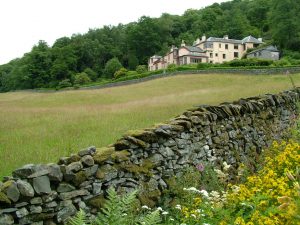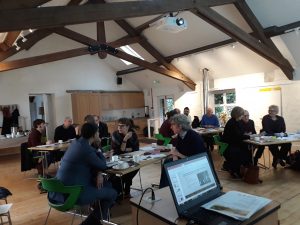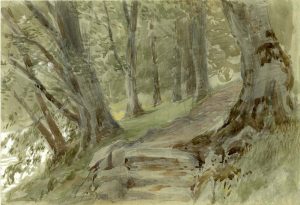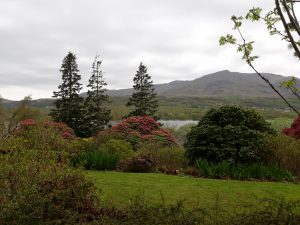This blog, about her exhibition at Brantwood, ‘Ruskin’s Good Looking!’ is written by Dr Sarah Casey, Senior Lecturer in Drawing and Installation at Lancaster Institute for the Contemporary Arts, Lancaster University
All over the country, indeed all over the world, we are currently celebrating Ruskin’s birth and reflecting on his legacy for the 21st century and beyond. This year, 20th February marked 200 years since Ruskin’s christening. The christening gown worn by the infant Ruskin on that day is one of several garments belonging to Ruskin now on display at Brantwood as part of the exhibition Ruskin’s Good Looking!, which celebrated its opening on 24th February. This event is the culmination of a two-year Lancaster University research project, examining Ruskin’s clothes through drawing. The project included testing ideas in The Ruskin’s 2018 seminar series (which took its title from this project, Ruskin’s Good Looking!) and public drawing workshops as part of the Being Human festival 2018.[1] The questions driving this activity are: What is it about drawing that continues to make it a valuable tool of investigation in fields ranging from natural history, to medicine, archaeology and fashion? How might Ruskin’s ideas about drawing be applied in the 21st century to develop new contemporary approaches to object based research?
Over the past two years I have had the extraordinary privilege to get up close and intimate with Ruskin’s clothing in the Brantwood collection and at nearby Keswick Museum. The research was based on the premise of using Ruskin’s belief in drawing as a means of seeing the world – a view he clearly expressed in The Elements of Drawing (1857): “I believe that the sight is a more important thing than the drawing; and I would rather teach drawing that my pupils learn to love Nature, than teach the looking at nature that they may learn to draw.” Drawing requires us to look and this helps us to understand. I applied this view to his own clothing.
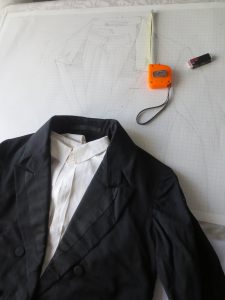
The first stage was simple – look, look again, and draw what you see. Using this elementary method, I made 1:1 scale pencil drawings of each garment on graph paper. I called these garment maps. Reflecting on the process, I came to realise a parallel with Ruskin’s methods of ‘true topology’, delineating what is observed in the landscape leaving ‘no stone unturned’ … although in my drawings, the landscape was the more intimate terrain of personal clothing. This was to reveal nuances in the clothing’s construction that might be read as fingerprint of Ruskin’s specific physiology. Artist Louise Bourgeois has described clothing as being like an envelope of a person, bearing the imprint of their body, a history so clear she calls garments ‘road signs’ to the past.[2]
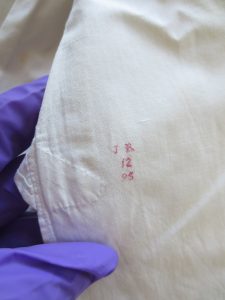
These ‘road signs’ are evident if we know how to look. Close looking through drawing is a method promoted by curator and ‘dress detective’ Ingrid Mida from Ryerson University, Toronto who visited Brantwood with me in April 2018 to examine the garments.[3] This provided valuable specialist insight into their use and wear. It was a magical moment when Ingrid first unfolded the shirt to find the laundry mark JR 12 95, which, as she writes in her catalogue essay, dates the shirt to December 1895, towards the end of Ruskin’s life.[4]
An equally exciting moment was when, studying the seams and crevices of a tailcoat, I discovered a tailors label marked ‘ John Ruskin Esq.’ affirming that the garment was indeed Ruskin’s and its provenance from his tailor (Stultz Wain & Co. 10 Clifford St London, for those of you interested).
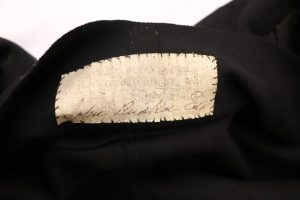
From these intense observational studies, I went on to make a series of wax drawings of the garments. Each garment map was transcribed onto a sheet of Japanese paper soaked in wax, using a simple dressmakers pin. The white marks that are visible are made by nothing more than the pressure of touching the surface.
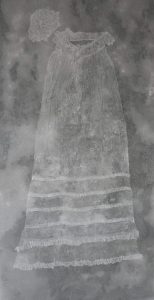
Like breath, or memory, the drawings have a fragile existence and will literally melt away if exposed to heat. As Anuradha Chatterjee’s catalogue explains, Ruskin believed clothing to reflect a person’s soul.[5] The wax drawings embrace this idea, taking on a spectral quality that evokes the uncanny sense of absent presence that is felt when examining a person’s clothes and looking into the past. As Ruskin said drawing enables us “to preserve something like a true image of beautiful things that pass away, or which you must yourself leave.”[6]
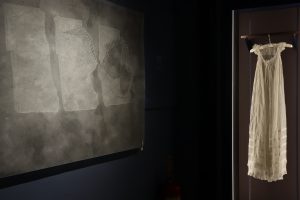
So, if you’re near Brantwood between now and 7th April, do take a look before they disappear…
To find out more about how this Ruskinian approach to drawing might benefit research in the 21st century, look out for Drawing Investigations: graphic relationships with science, culture and environment by Sarah Casey and Gerry Davies due for publication by Bloomsbury later this year.
[1] Sponsored by AHRC, the British Academy and Institute of Advanced Studies, University of London
[2] Louise Bourgeois in Marie Laure Bernadac, Louise Bourgeois, Paris: Flammarion, 2006, p.155.
[3] Supported by a grant from the Arts Council and British Council Artist International Development Fund.
[4] Ingrid Mida ‘A portrait of John Ruskin through his clothes’ in S. Casey (ed.) Ruskin’s Good Looking! (Lancaster University and Brantwood, 2019), p.13.
[5] Anuradha Chatterjee ‘Wearing the Soul John Ruskin’s theory of ideal dress’ in S. Casey (ed.) Ruskin’s Good Looking! (Lancaster University and Brantwood, 2019), pp.16-19.
[6] John Ruskin Elements of Drawing (1857). Letter 1, On First Practice.
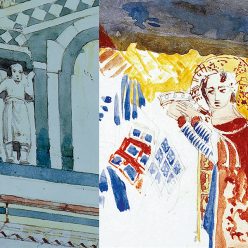
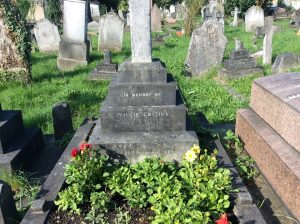
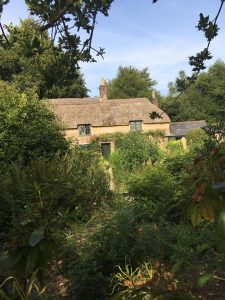
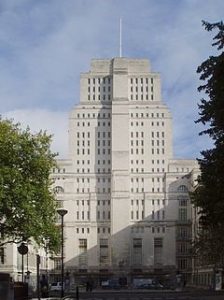
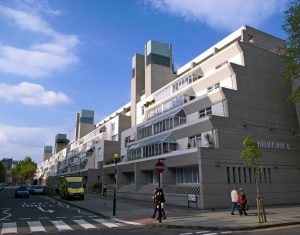
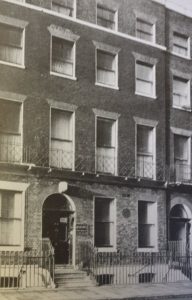 54
54 
